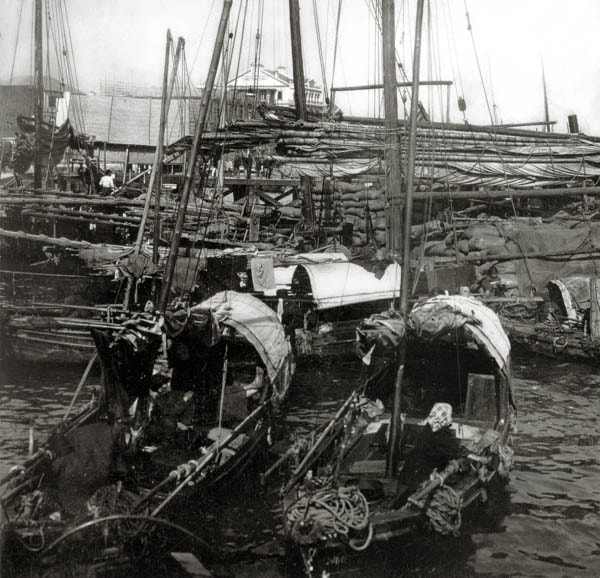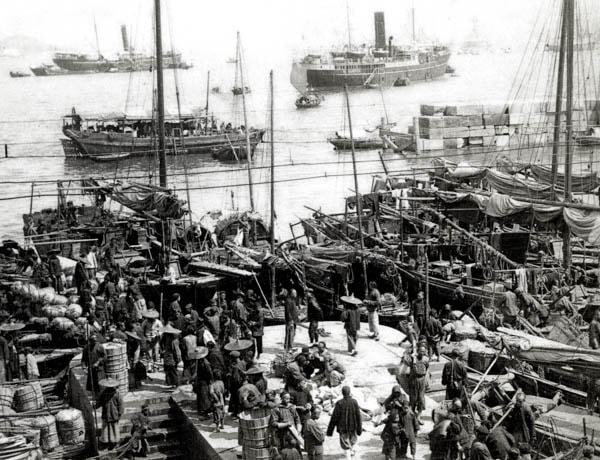Yuen Fat Hong (元發行)
Yuen Fat Hong was founded by Ko Yuen-sing (高元盛), a native of Chaozhou who migrated to Hong Kong around 1843.[34] Evidence suggests that its business was unsuccessful at the start. But after being taken over in 1853 by Ko Mun-wah (高滿華) (also known as Gao Chuxiang (高楚香)), a native of Chenghai and the joint owner of a junk plying between Siam and Chaozhou, Yuen Fat Hong began to expand and flourish. A total of five rice mills were set up in Bangkok, and rice was exported to Hong Kong for shipment to other Chinese cities in the north. Yuen Fat Hong grew to become one of the leading rice traders at the time. Apart from the rice trade, it was also involved in the handling of general cargo. Ko Mun-wah was a founder of Tung Wah Hospital, and a respected leader of the Chinese community in Hong Kong. The business was inherited by his son, Ko Shun-kam (高舜琴), who opened branches in South-East Asian ports including Singapore. It also ran a shipping agency business. For many years it acted for the Scottish Oriental Steamship Company, Norddeutscher Lloyd, and Butterfield and Swire’s steamers and cargo services between Hong Kong and Bangkok. The business was carried on by his sons and grandsons, but the firm eventually went bankrupt in the 1930s.
Kin Tye Lung (乾泰隆)
Kin Tye Lung was founded by Chen Wun-wing (陳煥榮), a native of Chenghai who migrated to Hong Kong in 1851.[35] Chen started his career as a sailor on board a trading junk based in Shantou. When he had accumulated some wealth, he began to build up his own fleet of trading junks sailing from Hong Kong and Shantou to Shanghai and Tianjin in the north and South-East Asia in the south. In 1851, after he had cultivated connections with cities on the mainland and in South-East Asia, he founded Kin Tye Lung, one of the earliest Nam Pak Hongs in Hong Kong. The business was inherited and expanded by his son Chen Cihong (陳慈黌), who started the firm Chen Hong Li (陳黌利行) in Bangkok. Rice granaries were constructed, and rice was shipped in large quantities to China via Hong Kong. Meanwhile, branch offices were established in Singapore and elsewhere in South-East Asia, and a substantial network of trade was established. The business of Kin Tye Lung was carried on by generations of capable descendants. It survived many hazards and economic downturns and is still in business today.
Kwok A-cheong (郭亞祥) and Fat Hing Hong(發興行)
Kwok A-cheong, also known as Kwok Kam-cheung (郭甘章) and Kwok Ching-shan (郭青山), came from the boat-dwelling community in Guangzhou.[36] He provided food to the British during the Anglo-Chinese rivalries in 1841. He settled in Hong Kong after the war and became a comprador of the Peninsular & Oriental Steamship Company, from which he acquired knowledge of modern shipping. When the company disposed of its shipwright and engineering department in 1854, Kwok took it over and developed his own fleet of steamships. At one time his fleet competed with the Hongkong Canton & Macao Steamboat Co. Apart from his shipping business, Kwok opened Fat Hing Hong, a general merchant house in Sheung Wan. He acquired substantial landholdings and became one of the richest men of his time. He was one of the founders of Tung Wah Hospital. Fat Hing Street in Western District was named after his firm.
Li Sing (李陞) and Wo Hing Hong (和興行)
Li Sing, also known as Li Yuk-hang (李玉衡), was one of the wealthiest merchants in Hong Kong in the 19th century.[37] He fled to Hong Kong when his home town, Xinhui, was occupied by Red Turban rebels in 1854. Together with his brother, who had settled in Hong Kong earlier, he founded Wo Hing Hong, a Kam Shan Chuang (金山莊), specialising in import and export trade with the United States. The firm was also involved in the profitable coolie trade. Later, Li Sing began to invest in real estate and owned many lots in the Sheung Wan and Western districts. He diversified into various ventures, and by the time of his death in 1900, his estates were valued at six million Hong Kong dollars, three times the annual revenue of the colonial government at the time. Li Sing was a founder of Tung Wah Hospital and Po Leung Kuk. He is remembered by a street named after him.
Notes:
- [34]May Holdsworth and Christopher Munn, Dictionary of Hong Kong Biography (Hong Kong: Hong Kong University Press, 2012), pp. 229-230; Carl Smith, ‘The Emergence of a Chinese Elite in Hong Kong’, JHKBRAS, 11, (1971).
- [35]陳煥溪:《潮人在香港》(香港:潮汕歷史文化研究中心,2006年8月版),頁17;張曉輝:《香港華商史》(香港:明報出版社有限公司,1998),頁8-9。
- [36]May Holdsworth and Christopher Munn, pp. 233-234; Smith, “The Emergence of a Chinese Elite in Hong Kong”.
- [37]May Holdsworth and Christopher Munn, pp. 264-265; Smith, ‘The Emergence of a Chinese Elite in Hong Kong’; 馮邦彥:《香港華資財團,1841-1997》,頁25-27。




